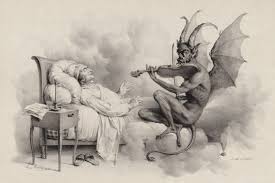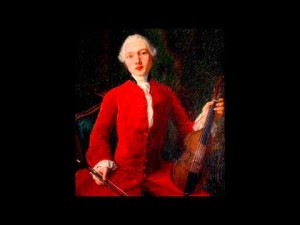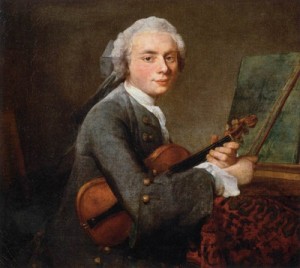« Charles Burney et les violonistes de son voyage ou des grands héritages pour l’’école du violon Italien du 18è siecle »
Charles Burney (1726-1814) mentionne beaucoup de personnalités musicales importantes dans son journal « The present state of music in France and Italy or the journal of a tour through those countries undertaken to collect materials for a general history of music » (1771). Parmi les compositeurs, les écrivains, les rois, les aristocrates et mécènes puissants, ou encore les musiciens du terroir et les paysans, place est faite aux violonistes. Burney consacre de longs moments à des violonistes italiens qu’il rencontre sur la route entre la France et l’Italie. Certains d’entre eux, comme Tartini, ont eu une influence notable sur l’histoire du violon. Les parties les plus interessantes sont certainement la description du jeu du violon, le son recherché, le tempérament de l’executant, et les impressions de Burney en tant qu’auditeur. L’auteur compare maitres et étudiants, et il nous donne une opinion subjective de ce qu’il entend.
Les violonistes les plus importants qui sont mentionnés dans le journal sont Giuseppe Tartini (1692-1770) et ses étudiants (directement ou par transmission sur plusieurs générations) ; parmi eux Pietro Nardini (1722-1793), Maddalena Lombardini (1745-1818), Jean-Pierre Pagin (1723-1799), mais aussi le célèbre étudiant de Giovanni Battista Somis (1686-1763)- Gaetano Pugnani (1731-1798), mais aussi d’autre, dont l’histoire de la musique ne retint que les noms, tels Michele Nasci (fl 1770), Emannuele Barbella (1718-1777), Eligio Celestino (1739-1812), Giovani Piantanida (1706-1773). Il est intéressant de voir que tous ces violonistes étaient à la fois compositeurs et parfois de brillants chanteurs.
Tous ces violonistes étaient eux-même des virtuoses et ils venaient donc de la tradition de l’un d’entre eux. Beaucoup d’entre eux continuèrent la tradition de la grande école italienne, qui débuta avec Corelli, Somis, Veracini, et se perpétua au travers de Tartini, Pugnani, Viotti, etc… Je me souviens que mon premier professeur de violon baroque me disait qu’il était possible de créer un arbre généalogique allant de Corelli à eux. Ce qui veut dire, même si ceci n’est bien sûr qu’une anecdote, que nous violonistes pouvons être fiers d’être les sucesseurs de la tradition musicale de Corelli et de Tartini !
« Tartini’s Dream » by Louis-Léopold Boilly (1824)
Un mot sur l’école de Tartini
L’école de Corelli a été développée par ses contemporains et ses étudiants, la transition s’étant effectuée via Veracini, dont l’influence sur Tartini fut des plus importante. Tartini commença ses actvités de professeur en 1727/8. Etant à ce moment-là déjà reconnu internationalement, beaucoup d’étudiants vinrent à lui de toute l’Europe. Ce fut la première école d’une telle envergure. D’apres la correspondance de Tartini, il n’enseignait pas seulement la technique du violon mais aussi la composition, et un cursus standart durait habituellement 2 ans.
D’un point de vue instrumental, l’école de Tartini était basée sur la virtuosité de la technique d’archet. « Your main exercise and study should be the bow, in such a way that you become a complete master of it, both in the « suonabile » and in the « cantabile » styles » : ceci est la premiere phrase de la lettre de Maddalena Lombardini dans laquelle la méthode de l’apprentissage est décrite. Une étude doit d’abord insister sur le mouvement d’imitation de l’opus 5 de Corelli (1700). Le contrôle total de l’archet est essentiel à la réalisation des innovations stylistiques de la musique de Tartini. Seul ce contrôle rend possible la réalisation correcte des cantabile, ainsi que les ornementations par lesquels une même mélodie peut être encore plus caractérisée. La technique de respiration des chanteurs trouve son pendant dans l’utilisation de l’archet. L’archet standard n’était pas assez long pour permettre à une mélodie de « chanter » véritablement sur l’instrument. C’est pourquoi Tartini fit faire des archets plus longs. Ca n’est pas un hasard si les 50 variations sur une gavotte de Corelli (à nouveau dans l’opus 5) portent le titre « L’arte dell’arco ». Tartini insistait auprès de ses étudiants sur l’utilisation de l’archet. « Force sans dureté, fléxibilité sans faiblesse », son engagement était écrit en lettres majuscules sur les pupitres de Tartini, et ponctuent l’apprentissage des grands virtuoses encore maintenant.
L’héritage de Tartini fut durable. La partie du traité de Leopold Mozart consacré aux ornements n’est en fait qu’une traduction de la première partie du traité de Tartini portant sur le même sujet. En outre, le cantabile à l’instrument devint l’une des caractéristiques majeures dans la musique du fils de Léopold.
Ainsi, qui Charlie a donc rencontré lors de son long voyage entre la France et l’Italie?
L’Étudiant de Corelli/Somis
Signor Pugnani (heard inTurin) :
« Signor Pugnani played a concerto this morning at the king’s chapel, which was crowded on the occasion. It in as elegant rotund, built of black marble, and happily constructed for music, being very high, and terminated a dome. I need say nothing of the performance of Signor Pugnani, his talents being too well known in England to require it. I shall only observe that he did not appear to exert himself: and it is not to be wondered at, as neither his Sardinian majesty, nor anyone »
Gaetano Pugnani was a student of Somis, who was a pupil of Corelli. His musical career was connected to the city of Torino, where in 1770, after his teacher, he became a concertmaster in orchestra of Teatro Regio. In 1754 he performed one of his own concertos at the Concert Spirituel in Paris, where his first published works appeared the same year. The Mercure de France wrote: « the connoisseurs insist that they have never heard a violinist superior to this virtuoso ». His most famous pupil was Viotti, with whom he went for a tour in the northern Europe (1780-82). Viotti called himself « eleve du celebre Pugnani » on his printed music. His playing was known for its power, eloquence and rich cantilena; his « arco magno » became his identification. He probably played an important part in the development of the modern bow: he himself used a bow (called an ‘archetto alla Pugnani’) that was straighter, longer and equipped with a screw, and he may have exchanged views with the Parisian bowmaker Tourte pere in 1754 and with the younger Francois Tourte in 1772–3. Pugnani also preferred to use thicker strings, perhaps because they were better able to withstand the greater pressure of his bowing. Burney observed that Pugnani, « though an able and celebrated professor on the violin, seems to have begun writing for the voice too late in life to arrive at great excellence in lyric compositions ». Nevertheless he takes significant place as a composer in the mid-century Italian classicism. He is an author of operas, symphonies and chamber music.
L’Étudiant de Tartini :
Monsieur Pagin (Paris)
« M. Pagin was a pupil of Tartini, and is regarded here as his best scholar; he has a great deal of expression and facility of executing difficulties; but whether he did not exert himself, as the room was not large, or from whatever cause it proceeded, I know not, but his tone was not powerful. Music is now no longer his profession; he has a place under the Comte de Clermont, of about two hundred and fifty pounds sterling a year. He had the honour of being hissed at the Concert Spirituel for daring to play in the Italian style, and this was the reason of his quitting the profession. »
The sources confirm that Pagin was one of the best Tartini’s students. His master said about him: « Go and hear Pagin, for you will still hear me ». The master begged 90 year-old Girolamo Amati to make the violin for his French pupil, and indeed this instrument, currently lost or re-labelled was the last which came from Amati’s family atelier. After studying, Pagin returned to Paris, and made his debut at Concert Spirituel at 1747 playing his own composition. He was responsible for arranging the publication of Tartini’s violin sonatas op. 4, 5, 6, 7, and 9. From that time until 1750, he often appeared as soloist at the Concert Spirituel, playing music by Tartini, Locatelli, and Vivaldi. But after he was no longer asked to play with them, perhaps due to his preferences of the repertoire- that’s what Burney reported. In 1748 Pagin published in Paris a set of six Sonates a violon seul et basse continue. They show the influence of his teacher, with a virtuoso use of trills and pedal points, extreme leaps in register, challenging chordal passages, a sophisticated and extensive use of articulation marks, and a range extending into the 7th position. Pagin was listed in Parisian almanacs as a violin teacher until 1785, so the Tartini school was continued in France after him.
Signor Carminati (Lyon):
« The first violin of this town is an old Venetian, Signor Carminati, one of the Tartini’s earliest scholars; and the principal performer on the harpsichord, Signor Leoni: but both have been here long enough to have accomodated themselves to the music and the taste of this country. »
Nardini (Padua):
« Nardini, who played to me many of his best solso, as I thought, very well, with respect to correctness and expression, told me that his dear and honoured master, as he constantly called him was as much superior to himself, in the performance of the same solos, both in the pathetic and briliant parts, as he was to anyone of his scholars. »
« Signor Nardini played both solo and a concerto, of his own compostion, in such a manner as to leave nothing to wish: his tone is even and sweet; he has a great deal of expression on his slow movements, whic it is said, he has happily caught form his master Tartini. As to execution, he will satisfy and please more than surprise: in short, he seems the completest player in the violin in Italy; and, according to my feelings and judgement, his stile is delicate, judicious and highly finished. »
In 1734 he was accepted as a pupil of Tartini and soon became his favourite student. He then undertook an intensive programme of teaching and giving public and private concerts, for which he often went abroad for long periods. He went to the court of Vienna, Stuttgart, Brunswick. During Tartini’s final illness he cared for the dying maestro with true affection and tenderness. Nardini was noted for his perfect technique, excellent bow control and a superb sound. Leopold Mozart heard him play in 1763 and remarked: « The beauty, purity and evenness of his tone and his cantabile cannot be surpassed »
In fact Burney mentioned: « Signor Nardini, was at Florence when I arrived there, and was universally admired. The Tomassino, as he is called, and the little Mozart, are talked of all over Italy as the most promising geniusses of this age »
Nardini was particularly famous for his performance of adagio movements, which were more suited to his lyrical rather than dramatic nature. According to Schubart, he managed to move even the most insensitive listeners by the deep emotions expressed so effortlessly and naturally. His compositions combine two elements typical of the Italian style in the 18th century: cantabile and passionate writing in slow movements and fluency in fast ones. Nardini’s wrote 12 violin sonatas and four violin concertos, all unpublished, and the six sonatas op.5 – which show the influence of Corelli and Tartini, and concertos op.1 date from about 1760- infuenced by Tartini again, but in fast-slow-fast structure; the overtures, harpsichord sonatas and Adagios brodes, six quartets, other violin sonatas and the flute concertos.
Signora Morelli (Florence)- Nardini’s student:
« At another great accademia, at the house of Signor Domenico Baldigiani, I this evening met wiht the famous Improvvisatrice, Signora Maddalena Morelli, commonly called La Corilla, who is likewise a scholar of Signor Nardini, on the violin; and afterwards I was frequently at her house*. Besides her wonderful talent of speaking verses extempore upon any given subject, and being able to play a ripieno part, on the violin, in concert, she sings with a great deal of expression, and has a considerable share of execution.
*she has, almost every evening, a conversazione, or asssembly, which is much frequented by the foreigners, and men of letters, at Florence. »
Maddalena Lombardini (Venice):
« It was here that the two celebrated female performers, the Archipate, now Signora Guglielmi, and Signora Maddalena Lombardini Sirmen, who have received such great and just applause in England, had their musical instructions. » « who has heard the polished performance of the celebrated Signora Sirmen, may form a pretty just idea of Signor’s Nardini manner of playing. »
There were no other musicians in her family and she became famous entirely through her own efforts. She must have been an outstanding violinist since in 1760 she was allowed to go to Padua to study violin and composition with Tartini. Due to the fact that the lessons were delayed, Tartini wrote her a long letter explaining his violin playing methods and the best way to practise. The letter was translated to English (by Burney), German and French and became an important source for all the violinists. Tartini tried unsuccessfully to find her a husband, but in the next year she married the violinist and composer Lodovico Sirmen, with whom she went for the European tour and played couple of times at the Concert Spirituel. She had two very successful seasons there as a violinist, playing in various concert series (including the Bach- Abel concerts) and at the theatres, followed by a third when she became a singer, in which she was also very talented. Her compositions were widely know during her life, published and reprinted by several different publishers in Paris, the Low Countries, Germany and London. Sirmen’s violin concerto was played in Stockholm in 1774, and in a letter from Salzburg to his wife and Wolfgang, Leopold Mozart said: « After the symphony Count Czernin played a beautifully written concerto by Sirmen. »
Signor Barbella (Naples):
« Barbella rather dissapointes me; his performance has nothing very surprising in it now; he is not young, indeed and solo playing is never wanted or regarded here so that teaching and orchestra playing are his chief employments. He performed, however, most admirably the famous Neopolitan air, which the common people constantly play Christmas to the Virgin; this he plays with a drone kind of bag-pipe base, in a very humorous, though delicate manner. But as a solo-player, though his tone is very even and sweet, he is inferior to Nardini, and, indeed, to several others in Italy; but he seems to know music well, and to have a good deal of fancy in his compositions which a tincture of not not dissagreeble madness. Barbella is the best natured creature imaginable; his temper, as one of the company observed, is as soft as the tone of his violin. But sitting next ot him, I acquired music biographical knowledge concerning old Neapolitan musicians. After supper, Barbella played extremely well several Calabrese, Leccese, and Neapolitan airs, and among the rest, a humorous piece composed by himself, which he callsTinna nonna; it is nurserry tune, or lullaby, excelent in its way, and was well expressed. »
He was a student of Angelo Zaga and by Pasqualino Bini, a noted pupil of Tartini. He studied also composition with Michele Cabbalone and Leonardo Leo. There is no evidence that Barbella ranked among the finest Italian violinists, he was respected as a performer and admired as a teacher and composer. Barbella’s compositions achieved a modest success in London and Paris.The craftsmanship is sure, but what seemed to Burney as « a good deal of fancy » appears as no more than an imitation of Tartini’s style. Occasional harmonic surprises (« a tincture of notdisagreeable madness »), may represent Barbella’s interpretation of Tartini’s harmonic theories. The humorous side is sometimes seen in strange programmatic titles and unusual tempo indications. His good temper and stable character probably contributed to his effectiveness as a teacher and to the esteem in which he was held by his contemporaries. His famous pupil was Ignazio Raimondi.
Other violinists mentioned during the journey:
Signor Piantanida (Bologna): « The morning service was finised by a symphony, with solo parts, by Signor Gioanni Piantanida, pricipal violin of Bologna, who really astonished me. This performer is upwards sixty years of age, and yet has all the fire of youth, with a good tone, and modern taste; and, upon the whole, seemed to me, though his bow- hand has a clumsy and awkward look, more powerful upon his instrument than any one I has, as yet, heard in Italy. »
When Burney meets him, he is already quite old, in fact he belonged rather to the generation of Tartini (he was 14 years younger). He spent some time teaching in Russia, he played tours in Germany, Holland and then he even joined Handel for some concerts in London. As almost all the violinist mentioned here, he played at the Concert Spirituel in 1743. Joachim Quantz compared Piantanida to Tartini. Opinions on his qualities as a composer, however, are ambigous- some admired the compositional skill of his sonatas while others and others accused him of plagiarism. The chronicler of Bologna mentioned that he « died suddenly in S. Petronio on the orchestra steps. He was the famous player. »
Signor Celestino (Rome): « The day after my arrival, at his Grace the Duke of Dorset’s, I heard Signor Celestino, the principal violin here, who is a very neat, and expressive performer. He played, among other things, one of his own solos, which was very pleasing, though extremely difficult, with great briliancy, taste, and precision. »
Indeed, in 1799 Celestino was hailed in London as the greatest violinist of his time. He had a great influence on the standard of the orchestra of the Mecklenburg-Schwerin court at a time when this ensemble, temporarily based in Ludwigslust, was one of the best in Germany. He toured in Holland, Sweden, France, Italy, German. He was also a muscian of Stuttgart court orchestra. He composed, mostly chamber music in the delightful style, his pieces in some ways resembles Mozart’s, though in a popular manner.
Violinists in Rome: « The best violin performers were, Signor Celestino, whom I before mentioned’ Signor Niccolai, a worthy scholar of Tartini, and Signor Roma, a young man whom I frequently heard at Signor Crispi’s concerts, who plays with great facility and neatness »
Signor Nasci (Naples): « Signor Nasci; who leads the band at the comic opera in the theatre de Fiorentini, played on the violin in the Dominican’s performance, and afterward in some of his own trios, which are extremely pretty, with a very uncommon degree of grace and facility. » Burney also heard him perform his trios at the home of William Hamilton, the British minister there. About 1771 his « Sonate sei di cembalo con accompagnamento di violino » were published in London, dedicated to Catherine Hamilton, an accomplished keyboard player. Burney might have been the agent himself- as the sale of his library in 1814 included manuscript copies of sonatas and trios by Nasci. Nasci’s other extant works include a sonata for violin and continuo and three violin concertos, and a solo motet with accompaniment for violins and continuo, composed in 1769 for the castrato Caffarelli. A further six concertos at the Naples Conservatory library and ascribed to Nasci are questionable on stylistic grounds. Other quatations about violinists in Burney’s Musical Journey. »
Signor Traversa (Paris): « Signor, Trevisa, first violin to the Prince de Carignan, then played execution, but this was not so well relished by the audience as the Exaudi that went before it. Nay, I could plainly discover, by their countenances and reception of it, how little they had felt it. »
Mister Fritz (Geneva): « M. Fritz, a good composer, and excellent player, on the violin, is still living; he has resisted here near thirty years, and is well known to all the English lovers of music who have visited Geneva during that time. In his youth he studied under Somis, at Turin. It was rather awkward to go to him, but I sent a message over night, and he appointed two o’clock the next day. He lives at the house about a mile out of town. I found him to be thin, sensible looking man, and we soon grew very well acquinted. He has so obliging as to play me one of his own solos, which, though extremely difficult, was pleasing; and notwithstanding his time of life, hw still performs with as much spirit as a young man of twenty-five. His bowing and expression are admirable, and he must himself be a real lover of music to keep it sich high practise, with so few opportunities od displaying his talents, or of receiving their due reward. He is on the point of publishing, by subscription, six symphonies. »
Signor Lucchini (Milan): « the first violin was played by Signor Luccuini, who leads at the burletta. As a principal violin, he is not of the first class, there is no want of hand, but great want of finishing; he had several solo parts given him, and made three or four closes. »
Signor Zuccherini (Milan): « the first violin was played by Zuccherini, who is reckoned here a good musician. » Performance of the double violin concerto of Raymond (Milan): « …with a duet violin concerto of Raymond, a German, very well written, and, though difficult, well executed, by two performers of diffrent powers, but both good in their way; one an elderly man, with great neatness ans delicacy of tone, but feeble; and other very young, with a force and fire which will soon render him a very great player; escpecially as to these requisites he joins expression; it was an admirable contest between age and youth, judgement and genius. »
Signor Nazari (Venice): « I heard Signor Nazari, the first violin of Venice, play a concerto; but we have long heard that instrument so well performed upon in England, that nothing is left to admire. However, Signor Nazari is certainly a very neat and pleasing player; his tone is even, sweet, and full; he plays with great facility and expression, and is, upon the whole, one of the best solo players that I had heard ont this side the Alps. Signor Nazari played here a concerto on the violin in a very neat and pleasing manner, I know not of whole composition, but it was by no means remarkable for novelty. »
Curious Signor Mazzanti (Rome): « Signor Mazzanti is famous for singing the poem of Tasso to the same melody as Gondoliers of Venice. This he does with infinite taste, accompanying himself on the violin, with the harmony of which he produces curious and pleasing effects. I prevailed on him to write me down the original melody, in order to compare it with one that I took down at Venice, while it was singing on the great canal. He composed many things himslef, such as operas and motets for voices; and trios, quartets, quintets, and other pieces for violins. He plays pretty well on the violin, and is in posession of the most beautiful Steiner I ever saw. »
A violinist in Naples: « A concerto on the violin was likewise introduced, where hand and fire discovered by the player, but no taste or finishing. »
« The Youth With A Violin » (1734-1735) Jean-Baptiste-Siméon Chardin (1699-1779)
Klaudia







